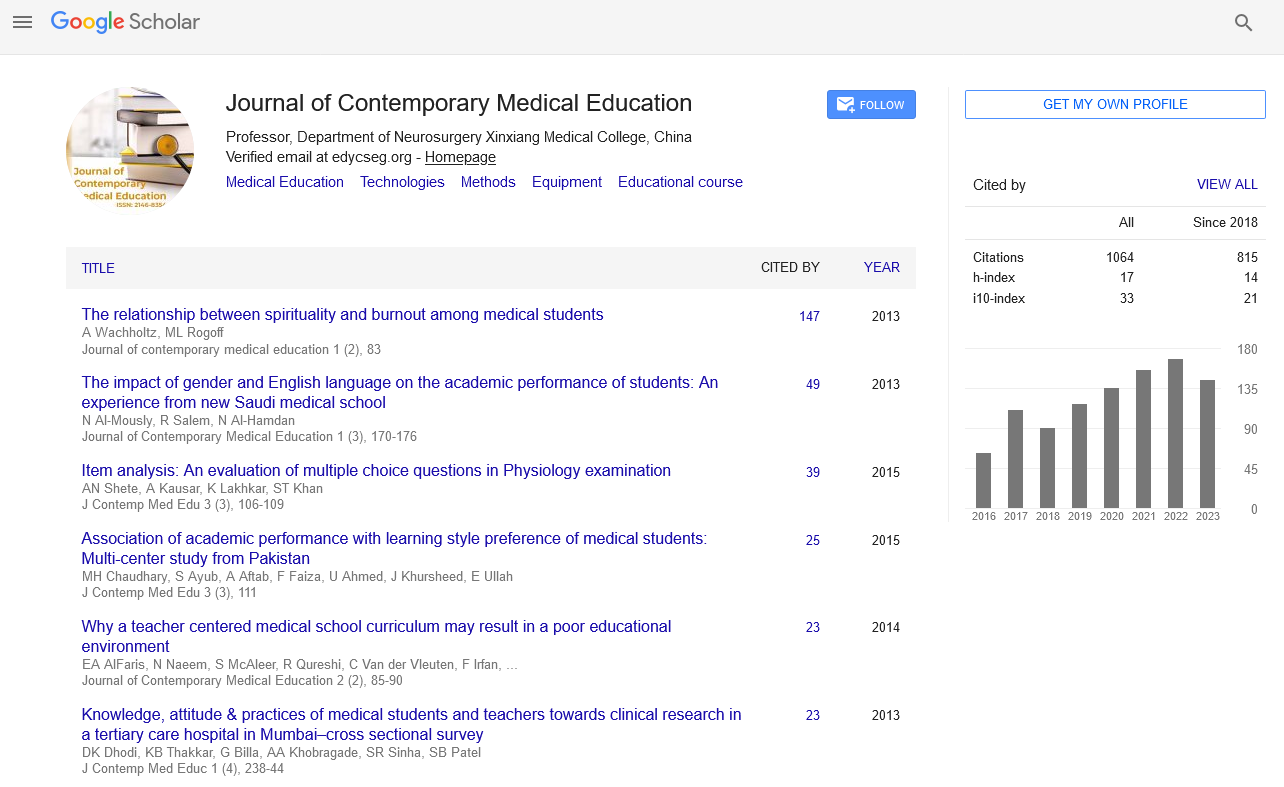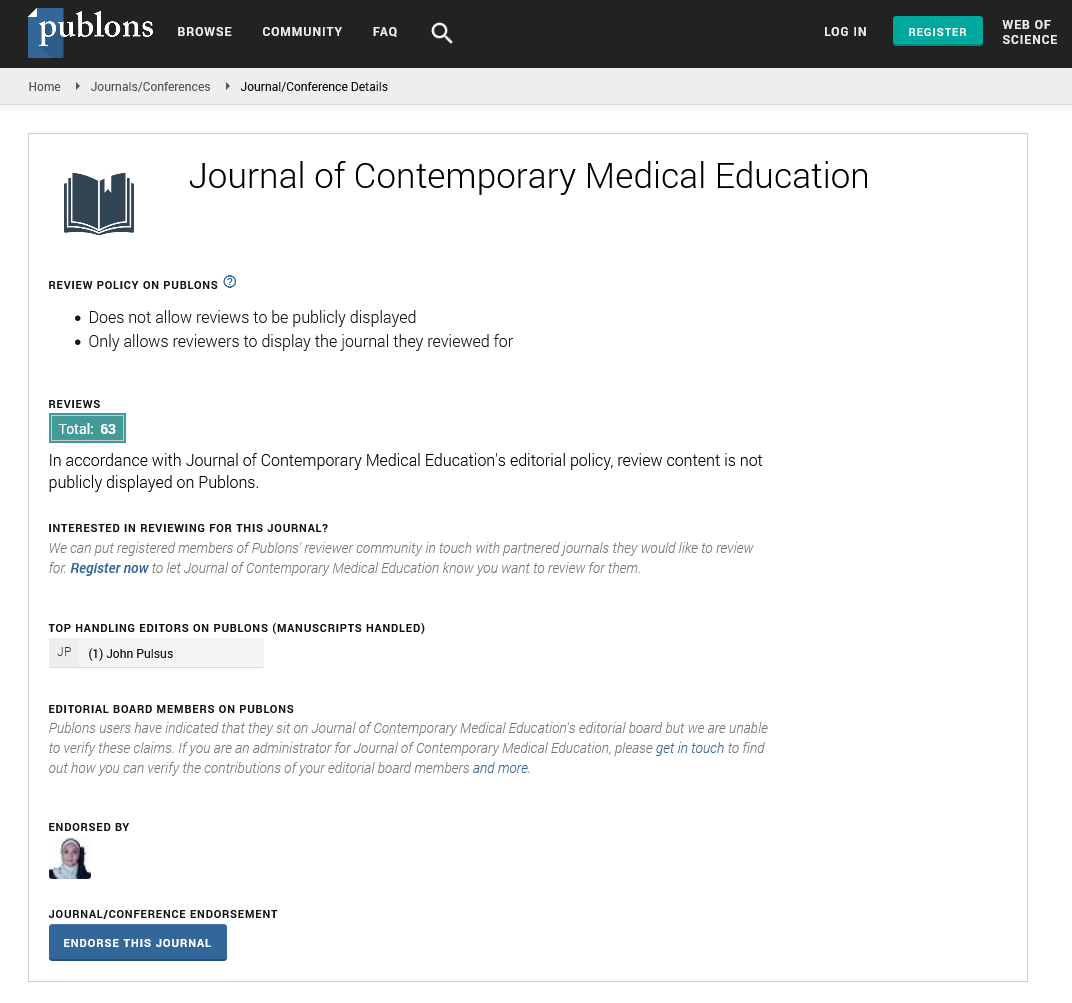Commentary - Journal of Contemporary Medical Education (2023)
The Acupuncture Medicine: Exploring Its Origins, Principles, and Modern Applications
Jeni Marthon*Jeni Marthon, Department of Pathology, University of Cambridge, Cambridge, United Kingdom, Email: Jenimarthon@gmail.com
Received: 02-Jun-2023, Manuscript No. JCMEDU-23-102164 ; Editor assigned: 05-Jun-2023, Pre QC No. JCMEDU-23-102164 (PQ); Reviewed: 19-Jun-2023, QC No. JCMEDU-23-102164 ; Revised: 26-Jun-2023, Manuscript No. JCMEDU-23-102164 (R); Published: 03-Jul-2023
Description
Acupuncture is an ancient healing practice that has been utilized for thousands of years in traditional Chinese medicine. It involves the insertion of thin needles into specific points on the body to promote balance and restore health. This form of therapy has gained widespread recognition and acceptance in the modern world due to its effectiveness and holistic approach. This study discusses about the origins of acupuncture, its fundamental principles, and its diverse applications in contemporary healthcare.
Origins of acupuncture
The origins of acupuncture can be traced back to ancient China, where it was developed over 2,500 years ago. The practice is deeply rooted in the philosophy of traditional Chinese medicine, which views the body as a complex network of interconnected energy channels known as meridians. These meridians conduct Qi (pronounced “chee”), the vital life force that flows throughout the body [1]. According to legend, acupuncture was discovered when ancient Chinese healers noticed that soldiers who were wounded by arrows experienced pain relief in other parts of their bodies [2]. This observation led to the development of acupuncture techniques aimed at manipulating the flow of Qi to promote healing and alleviate pain [3].
Fundamental principles of acupuncture
Acupuncture is based on several key principles that underpin its therapeutic effects. One of the fundamental concepts is the notion of Yin and Yang, opposing forces that exist in the body and need to be balanced for optimal health [4]. Illness and disease are believed to arise from an imbalance of Yin and Yang, and acupuncture aims to restore equilibrium by regulating the flow of Qi. Another essential principle is the identification of acupuncture points, which are specific locations on the body where needles are inserted [5]. These points are believed to correspond to energy pathways or meridians that connect to specific organs or body systems. By stimulating these points, acupuncturists aim to restore the proper flow of Qi, promoting the body’s natural healing abilities [6].
Modern applications of acupuncture
Acupuncture has gained recognition worldwide as a complementary therapy for various health conditions. Numerous studies have demonstrated its effectiveness in pain management, particularly for chronic pain conditions such as lower back pain, osteoarthritis, and migraines. Acupuncture is believed to stimulate the release of endorphins, the body’s natural painkillers, and modulate the nervous system to alleviate pain [7]. Beyond pain management, acupuncture has been utilized in the treatment of various disorders, including anxiety, depression, insomnia, and digestive issues [8]. Its holistic approach aims to address the underlying imbalances in the body, promoting overall well-being and improving the body’s resilience to illness. In recent years, acupuncture has also found applications in women’s health, supporting fertility, alleviating menstrual disorders, and assisting in the management of menopausal symptoms. Additionally, acupuncture is increasingly used as an adjunct therapy in cancer care to alleviate treatment-related side effects such as nausea, fatigue, and pain [9].
Safety and considerations
Acupuncture is generally considered safe when performed by trained and licensed practitioners. The needles used are extremely thin and sterile, minimizing the risk of infection. However, it is crucial to seek treatment from a qualified acupuncturist to ensure proper hygiene and technique [10]. It is worth noting that acupuncture should not be viewed as a standalone treatment for severe or life-threatening conditions. Instead, it is often used in conjunction with conventional medical interventions to enhance overall well-being and support the body’s healing processes.
References
- Berman BM, Langevin HM, Witt CM, Dubner R. Acupuncture for chronic low back pain. N Engl J Med 2010;363(5):454-461.
[Crossref] [Google Scholar] [PubMed]
- Adams D, Cheng F, Jou H, Aung S, Yasui Y, Vohra S. The safety of pediatric acupuncture: a systematic review. Pediatrics 2011;128(6):e1575-e1587.
[Crossref] [Google Scholar] [PubMed]
- Wang SM, Harris RE, Lin YC, Gan TJ. Acupuncture in 21st century anesthesia: is there a needle in the haystack?. Anesth Analg 2013;116(6):1356-1359.
[Crossref] [Google Scholar] [PubMed]
- Ernst E. Acupuncture–a critical analysis. J Intern Med 2006;259(2):125-137.
[Crossref] [Google Scholar] [PubMed]
- Ahn CB, Jang KJ, Yoon HM, Kim CH, Min YK, Song CH, et al. A study of the Sa-Ahm five element acupuncture theory. J Acupunct Meridian Stud 2009;2(4):309-320.
[Crossref] [Google Scholar] [PubMed]
- Ernst E, Lee MS, Choi TY. Acupuncture: does it alleviate pain and are there serious risks? A review of reviews. Pain 2011;152(4):755-764.
[Crossref] [Google Scholar] [PubMed]
- Hall H. Acupuncture’s claims punctured: not proven effective for pain, not harmless. Pain 2011;152(4):711-712.
[Crossref] [Google Scholar] [PubMed]
- Sherman KJ, Cherkin DC, Eisenberg DM, Erro J, Hrbek A, Deyo RA. The practice of acupuncture: who are the providers and what do they do?. Ann Fam Med 2005;3(2):151-158.
[Crossref] [Google Scholar] [PubMed]
- White AR, Filshie J, Cummings TM. Clinical trials of acupuncture: consensus recommendations for optimal treatment, sham controls and blinding. Complement Ther Med 2001;9(4):237-245.
[Crossref] [Google Scholar] [PubMed]
- Johnson MI. The clinical effectiveness of acupuncture for pain relief–you can be certain of uncertainty. Acupunct Med 2006;24(2):71-79.
[Crossref] [Google Scholar] [PubMed]
Copyright: © 2023 The Authors. This is an open access article under the terms of the Creative Commons Attribution Non Commercial Share Alike 4.0 (https://creativecommons.org/licenses/by-nc-sa/4.0/). This is an open access article distributed under the terms of the Creative Commons Attribution License, which permits unrestricted use, distribution, and reproduction in any medium, provided the original work is properly cited.







